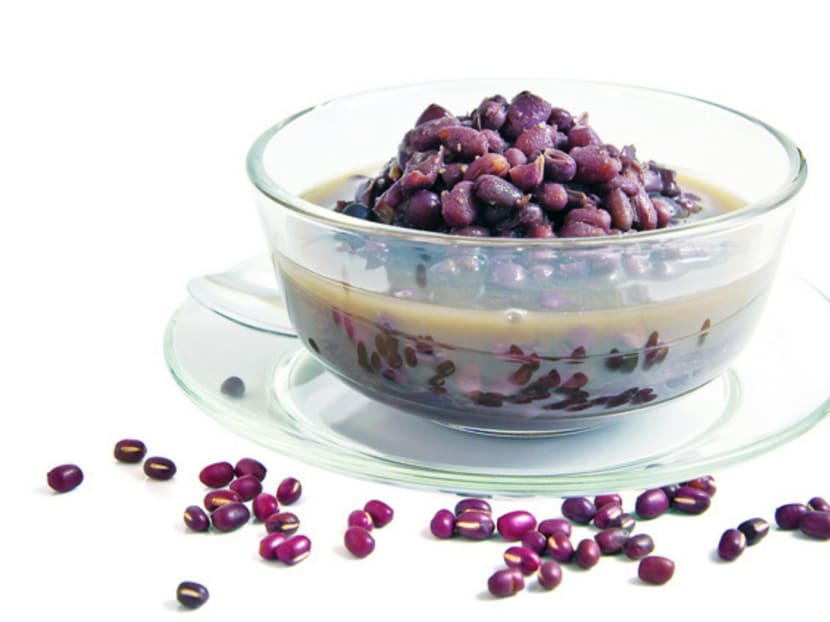Local superfoods that pack a health punch
SINGAPORE — Not all foods are created equal — some contain more vitamins, minerals and antioxidants than others.

Local dessert red bean soup is rich in antioxidants. Photo: Thinkstock
SINGAPORE — Not all foods are created equal — some contain more vitamins, minerals and antioxidants than others.
Including such foods in your diet, said Ms Teo Kiok Seng, nutritionist and director of Nutrition Network Services, may help reduce the risk of disease as well as improve your general health and well-being.
The best thing is, many of these foods are affordable and found in Asian dishes, so you don’t have to bust your budget to eat well. Here are seven to start you with.
1. SPINACH
Popeye’s favourite vegetable is rich in vitamins A, C, K, E and B as well as minerals such as iron, magnesium, calcium and potassium.
Spinach cooks easily, so stir-frying with a little oil preserves most of its nutrients, said Ms Teo. When added to soups, make sure you drink the liquid for the water-soluble vitamins B and C from the spinach, she said.
“Vitamin C in vegetables oxidises when exposed to oxygen in the air, so be sure to eat them as soon as you can after they are cooked,” said Ms Teo.
2. ALMOND
Almonds are rich in heart-healthy monounsaturated fat and phytosterols, said Ms Teo. The latter are plant sterols that can help lower “bad” cholesterol (low-density lipoprotein, or LDL) levels and strengthen bones, she said.
Almond is a low glycaemic index food that is also suitable for diabetics as it digests slowly and stabilises blood sugar levels, said Ms Teo. However, she cautioned that almonds also have a high fat and calorie content (100g has about 600 calories), so eat them in moderation.
3. GARLIC
In an Asia Pacific Biotech News report published in March, authors Associate Professor Koh Hwee Ling and Ms Siew Yin Yin from the Department of Pharmacy, Faculty of Science at National University of Singapore (NUS), said that studies have shown that eating garlic may be useful in treating mild high blood pressure and in reducing the hardening of arteries.
A 2013 study in the European Journal of Clinical Nutrition suggests that aged garlic extract may even stop the progression of heart disease. In some cases, it may reverse artery plaque accumulation.
When used in small quantities for flavouring dishes, garlic is generally safe. However, consuming large quantities for prolonged periods may create undesirable effects, said Assoc Prof Koh, a lecturer and researcher at NUS, and also a registered pharmacist with the Singapore Pharmacy Council.
The authors warned that eating garlic raw may cause side effects such as heartburn, stomach upset and allergic reactions. Garlic may also thin blood so it should be used with caution before surgery, dental work or if there is a bleeding disorder, they said.
4. PUMPKIN
A low-calorie and high-fibre vegetable, pumpkin is often recommended as part of a healthy diet for weight management, said Ms Teo. Pumpkin is also rich in vitamins C and E, and beta-carotene (the plant form of vitamin A), which lowers the risk of heart diseases and has cancer-preventive benefits.
Pumpkin seeds are rich in good fats, as well as an excellent source of protein, dietary fibre, vitamin B, iron, zinc, folate, manganese, magnesium and phosphorus.
Sneak pumpkin seeds into your diet by adding them to salads, oats or cereal, said Ms Teo. Pumpkin can also be used in porridge, soups, curries, stews and baked goods.
5. RED BEAN
A study conducted by the US Department of Agriculture, said Ms Teo, found that red bean tops 100 other foods in its antioxidant content. Antioxidants help fight harmful free radicals that can damage cells. Scientists believe this cell damage is one of the factors that lead to the development of certain diseases, including cancer and heart disease.
Red bean’s water-soluble fibre can lower cholesterol levels and help maintain a more stable blood sugar level, said Ms Teo. They are also low in fat and are cholesterol-free.
In addition, red beans are a good source of protein. According to the Health Promotion Board’s Healthy Plate Model, one three-quarter mug of red beans has the same amount of protein as one serving of meat, said Ms Teo.
6. PETAI BEANS
These beans are commonly stir-fried with chilli and shrimp paste in Malay or Indonesian cuisine. They can also be eaten raw.
Petai beans are rich in fibre, iron, potassium and tryptophan — an amino acid that may help boost mood and sleep — said the NUS authors. Other purported health benefits include lowering blood pressure and blood sugar, and alleviating constipation.
7. GOJI BERRIES
The NUS authors said that studies have found that these berries contain significant quantities of zeaxanthin and lutein — carotenoid pigments that have been shown to protect the eyes and are important for healthy vision.
In a 2009 study published in Journal of Medicinal Food, researchers found that goji berry juice enhanced immune response in healthy adults aged 55 to 72 years.





